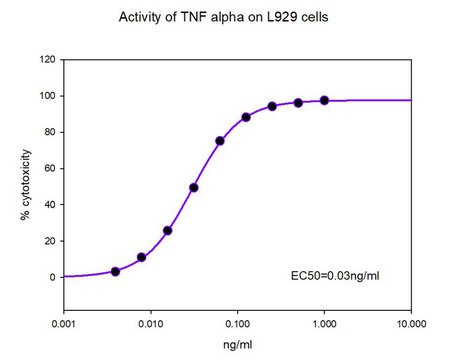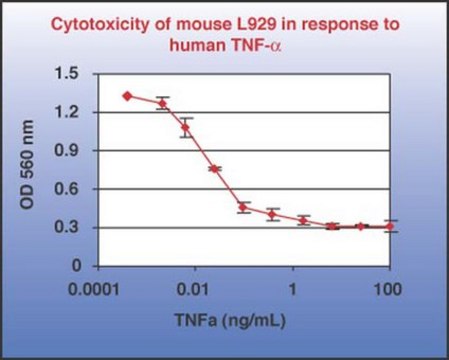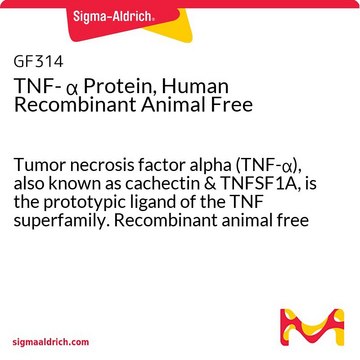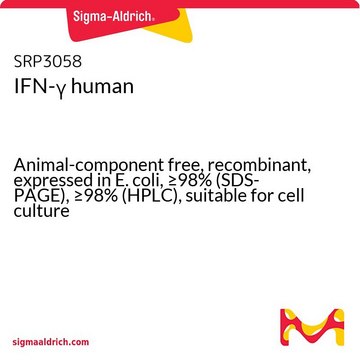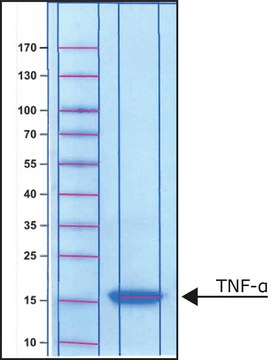T6674
Tumor Necrosis Factor-α human
≥97% (SDS-PAGE), recombinant, expressed in E. coli, powder, suitable for cell culture
Synonym(s):
hTNF-α, TNF-α
Select a Size
Select a Size
About This Item
Recommended Products
Product Name
Tumor Necrosis Factor-α human, TNF-α, recombinant, expressed in E. coli, powder, suitable for cell culture
biological source
human
Quality Level
recombinant
expressed in E. coli
Assay
≥97% (SDS-PAGE)
form
powder
potency
0.02-0.3 ng/mL ED50/EC50
quality
endotoxin tested
mol wt
~17.4 kDa
packaging
pkg of 5x10 μg
pkg of 10 μg
Looking for similar products? Visit Product Comparison Guide
Application
- to analyze the effects of cytokine TNFα-stressed human neuronal and glial (HNG) cells
- to investigate the molecular mechanisms of TNFα-mediated prolyl-4 hydroxylase α1 (P4Hα1) suppression
- to induce death-receptor-mediated apoptosis in HeLa cells.
Biochem/physiol Actions
Physical form
Analysis Note
Regulatory Information
Choose from one of the most recent versions:
Already Own This Product?
Find documentation for the products that you have recently purchased in the Document Library.
Which document(s) contains shelf-life or expiration date information for a given product?
If available for a given product, the recommended re-test date or the expiration date can be found on the Certificate of Analysis.
How do I get lot-specific information or a Certificate of Analysis?
The lot specific COA document can be found by entering the lot number above under the "Documents" section.
How do I find price and availability?
There are several ways to find pricing and availability for our products. Once you log onto our website, you will find the price and availability displayed on the product detail page. You can contact any of our Customer Sales and Service offices to receive a quote. USA customers: 1-800-325-3010 or view local office numbers.
What is the Department of Transportation shipping information for this product?
Transportation information can be found in Section 14 of the product's (M)SDS.To access the shipping information for this material, use the link on the product detail page for the product.
What is the package size of Product T6674, Tumor Necrosis Factor-α human?
It is a 10μg size-power form.
What are the units/mg of Product T6674, Tumor Necrosis Factor-α human?
1ug=1.1x10e5 units.
What is the solubility of this Product T6674, Tumor Necrosis Factor-α human?
This can be dissolved at 0.1 to 1.0 mg/ml in saline or buffer, stabilized with 0.1 to 1%BSA.
What is the EC50 of Product T6674, Tumor Necrosis Factor-α human?
Bioactivity(cell inhibition, L929 cells) is expressed by an EC50 of 0.02 to 0.05 ng/mL for T6674. EC50 (equivalent concentration) is the same as ED50 (equivalent dose, cytotoxicity, L929 cells) used for the bioactivity specification for T0157, Tumor Necrosis Factor-alpha, human recombinant expressed in Yeast.
My question is not addressed here, how can I contact Technical Service for assistance?
Ask a Scientist here.
Protocols
WST-1 assay protocol for cell viability and cytotoxicity measurements with preparation instructions, applications, FAQs, and troubleshooting.
XTT assay protocol for measuring cell viability, proliferation, activation and cytotoxicity. Instructions for XTT reagent preparation and examples of applications.
MTT assay protocol for measuring cell viability, proliferation and cytotoxicity. Instructions for MTT reagent preparation and examples of applications.
Our team of scientists has experience in all areas of research including Life Science, Material Science, Chemical Synthesis, Chromatography, Analytical and many others.
Contact Technical Service
